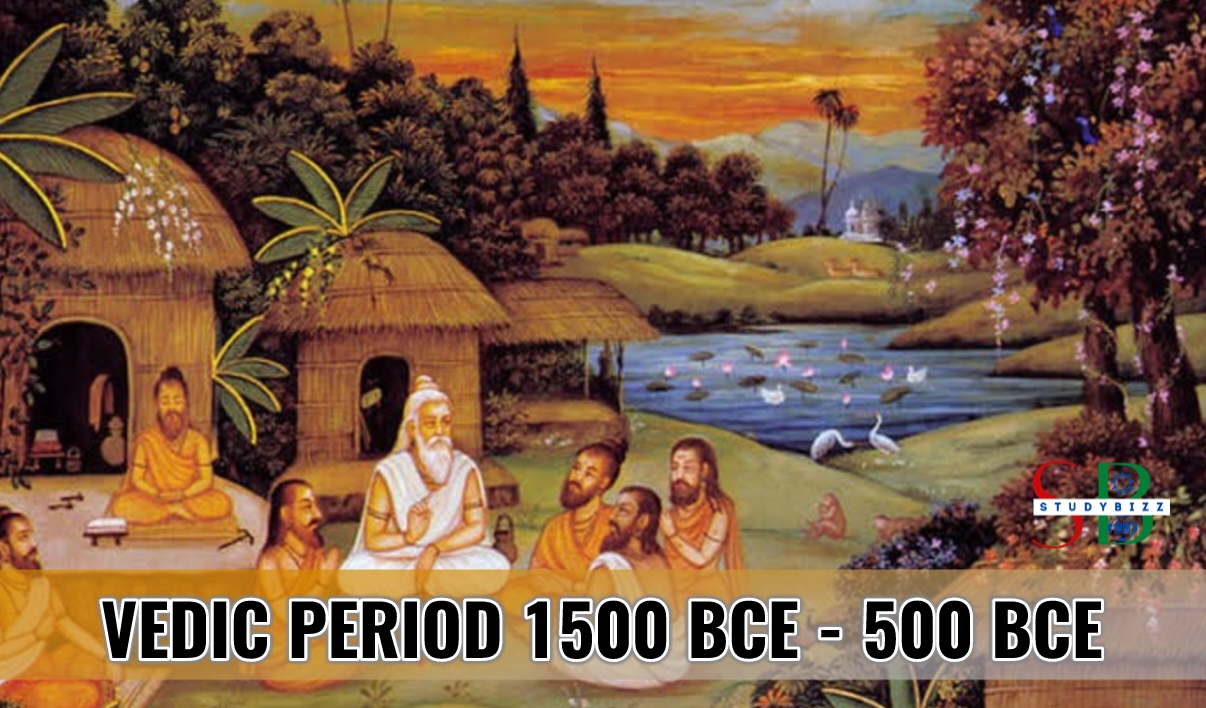The Vedic period is the period of ancient Indian history during which the Vedas, the oldest sacred texts of Hinduism, were written. It is traditionally dated to have occurred between 1500 BCE and 500 BCE, although the exact dates are still a matter of scholarly debate. During this period, early Indian society was primarily organized around a system of tribes and kingdoms, with a strong emphasis on the worship of gods and goddesses through ritual sacrifice. The society was primarily pastoral and agricultural, with a strong warrior class. The Vedic period saw the development of early Indian philosophy, including the emergence of the caste system and the concept of karma. The Vedas, which were passed down orally for many generations before being written down, continue to have a significant influence on Hinduism and Indian culture to this day.
Original Home and Identity :
The origin of the Vedic civilization and the identity of the people who composed the Vedas are still subjects of scholarly debate and ongoing research. The traditional view, based on the references in the Vedas themselves, is that the Vedic people were migrants from the northwest into the Indian subcontinent. They were known as Aryans, and their original homeland is believed to have been somewhere in Central Asia or Eastern Europe.
The Aryan theory is supported by linguistic and genetic evidence, which suggests that the Indo-European language family, to which the language of the Vedas belongs, originated in the Pontic-Caspian steppe region. However, the Aryan theory has been challenged in recent years by some scholars who argue that the Vedic civilization was indigenous to the Indian subcontinent and that the Aryans were a local tribe.
The exact location of the homeland of the Vedic people remains a subject of ongoing debate, and more research is needed to confirm the origins and identity of the Vedic civilization. It is widely accepted that the Vedic civilization emerged in the Indian subcontinent, and it is believed to have played a significant role in shaping the early history and culture of India.
Geography :
Early Vedic Period :
The geography of the early Vedic period, also known as the Rigvedic period, is primarily described in the Rigveda, the oldest of the four Vedas. The Rigveda was composed in an area that is now part of northern India and Pakistan, and it provides a detailed picture of the landscape and geography of the region during that time.
The Rigveda describes the early Vedic civilization as being primarily located in the region known as the Sapta-Sindhu, which refers to the land of the seven rivers. The rivers mentioned in the Rigveda include the Indus, the Sarasvati, the Ganges, the Yamuna, the Sutlej, the Beas, and the Ravi. These rivers provided water for agriculture and supported a wide variety of plant and animal life, making the region ideal for human habitation.
The early Vedic people lived in a primarily pastoral society, with a strong emphasis on cattle-rearing. The Rigveda describes the region as being rich in grass, trees, and forests, with a diverse range of flora and fauna. The region is also described as having a wide range of geographical features, including mountains, valleys, and deserts. The geographical descriptions found in the Rigveda are often metaphorical in nature, and it’s been argued that they reflect the perception of the poets and not the geographical reality.
The Rigveda also describes the Himalayas as a sacred place, and it’s believed that the early Vedic people had a strong connection to the mountain ranges, which were considered the source of many of the rivers mentioned in the Rigveda. The ocean is also described in the Rigveda, and it’s believed to be the source of all life.
Later Vedic Period :
The geography of the later Vedic period, also known as the later Vedic age or the Brahmanic period, is primarily described in the later Vedic texts, such as the Brahmanas, Aranyakas, and Upanishads. These texts were composed in an area that is now part of northern India and Pakistan and provide a detailed picture of the landscape and geography of the region during that time.
The later Vedic texts describe the civilization as being primarily located in the region known as the Ganges-Yamuna doab, which is the region between the Ganges and Yamuna rivers. This region was considered to be the heartland of the later Vedic civilization and was known for its rich soil and abundant water resources. The texts also refer to several other regions, such as Kuru-Panchala, which was located to the west of the Ganges-Yamuna doab, and Kosala, located to the east of it.
The later Vedic texts also describe the development of urban centers and the emergence of small states and kingdoms. These urban centers were located along the major trade routes and were centers of economic, political and cultural activity. The later Vedic texts also refer to the existence of forts and fortifications, indicating the emergence of military power and the possibility of conflicts.
The later Vedic texts continue to describe the Himalayas as a sacred place, the source of many of the rivers and the abode of the gods. The ocean is also described as a sacred body of water, and it’s believed that it was the source of all life.
It’s important to note that the later Vedic texts were written down during a period of political and social changes, and the geographical references in these texts reflect the perception of the poets and the political and economic realities of the time. The texts also reflect the religious and spiritual beliefs of the later Vedic people and the importance of the natural world in their worldview.
Political Structure :
Early Vedic Period :
The political structure of the early Vedic period, also known as the Rigvedic period, is primarily described in the Rigveda, the oldest of the four Vedas. During this period, early Indian society was primarily organized around a system of tribes and small chiefdoms, with a strong emphasis on the worship of gods and goddesses through ritual sacrifice.
The early Vedic society was primarily organized around a system of tribes known as jana or vis. Each tribe had its own chief, known as a rajan or raja, who was responsible for leading the tribe in war and peace. The rajan was chosen by the members of the tribe and his authority was based on his ability to lead in battle and provide for the welfare of the tribe.
The early Vedic society was also divided into two classes, the Kshatriyas (warriors) and the Brahmins (priests). The Kshatriyas were responsible for defending the tribe and leading it in battle, while the Brahmins were responsible for performing religious rituals and maintaining the tribe’s spiritual well-being.
The early Vedic tribes were semi-nomadic and they were organized around pastoralism, which means that they were mainly based on cattle-rearing. This made the tribes highly mobile and allowed them to follow their herds to new pastures. This type of organization made it hard for a centralized political power to emerge.
Later Vedic Period :
The political structure of the later Vedic period, also known as the later Vedic age or the Brahmanic period, is primarily described in the later Vedic texts, such as the Brahmanas, Aranyakas, and Upanishads. During this period, Indian society saw the emergence of small kingdoms and city-states.
During the later Vedic period, the political structure became more complex and began to take on a more centralized form. The tribes and small chiefdoms of the early Vedic period began to evolve into small kingdoms and city-states, each ruled by a king or chieftain. These kingdoms were often at war with one another, and the king’s main duty was to lead his kingdom in battle and defend it against invaders.
The later Vedic kings were also responsible for maintaining law and order within their kingdom, and they were often assisted by a council of nobles. The later Vedic texts also refer to the existence of forts and fortifications, indicating the emergence of military power and the possibility of conflicts.
The later Vedic period also saw the development of a caste system, which divided society into four main classes: the Brahmins (priests), the Kshatriyas (warriors), the Vaishyas (merchants and farmers), and the Shudras (servants and labourers). The Brahmins played an important role in the political structure, as they were responsible for performing religious rituals and maintaining the spiritual well-being of the kingdom.
The later Vedic period also saw the emergence of urban centers and the growth of trade and commerce. These urban centers were located along the major trade routes and were centers of economic, political, and cultural activity.
Economical life :
Early Vedic Period :
The economic life of the early Vedic period, also known as the Rigvedic period, is primarily described in the Rigveda, the oldest of the four Vedas. During this period, early Indian society was primarily organized around a system of pastoralism and agriculture.
The early Vedic society was primarily based on cattle-rearing, and the economy was centered around the raising and trading of cattle. Cows, sheep, and goats were the main source of wealth, and they were also used for milk, meat, and hides. Cattle were also used as a form of currency and were given as gifts and used to pay for brides.
Agriculture was also an important part of the early Vedic economy, and the people grew crops such as barley, wheat, and lentils. The Rigveda also mentions the use of plows and yokes for cultivation. The people also gathered wild fruits, nuts, and berries, and hunted wild animals for food.
The early Vedic society was also divided into two classes, the Kshatriyas (warriors) and the Brahmins (priests). The Kshatriyas were responsible for defending the tribe and leading it in battle, while the Brahmins were responsible for performing religious rituals and maintaining the tribe’s spiritual well-being.
The economy of the early Vedic period was relatively simple, and it was based on the exchange of goods and services among members of the tribe. There was little trade with other tribes or regions, and the economy was primarily self-sufficient.
Later Vedic Period :
The economic life of the later Vedic period, also known as the later Vedic age or the Brahmanic period, is primarily described in the later Vedic texts, such as the Brahmanas, Aranyakas, and Upanishads. During this period, Indian society saw the emergence of small kingdoms and city-states, and the economy became more complex and diversified.
Agriculture continued to be an important part of the economy during the later Vedic period, and the people grew crops such as barley, wheat, rice, and lentils. The use of iron tools, such as plows and sickles, was introduced, making agriculture more efficient. The later Vedic texts also mention the use of irrigation systems and the cultivation of fruits and vegetables.
Animal husbandry remained an important part of the economy, but the emphasis shifted from cattle-rearing to horse-rearing. Horses were used for transportation, as well as for war and hunting.
The later Vedic period also saw the emergence of trade and commerce. The people traded goods such as textiles, metals, and jewelry. The later Vedic texts also mention the existence of guilds and merchants, indicating a growth in trade and commerce. The use of coins as a medium of exchange was also introduced during this period.
The later Vedic period also saw the development of a caste system, which divided society into four main classes: the Brahmins (priests), the Kshatriyas (warriors), the Vaishyas (merchants and farmers), and the Shudras (servants and labourers). Each caste had its own economic role and responsibilities.
The later Vedic period saw the emergence of urban centers and the growth of trade and commerce. These urban centers were located along the major trade routes and were centers of economic, political, and cultural activity.
Vedic Society :
Early Vedic Period :
The Vedic society of the early Vedic period, also known as the Rigvedic period, is primarily described in the Rigveda, the oldest of the four Vedas. During this period, early Indian society was primarily organized around a system of tribes and small chiefdoms, with a strong emphasis on the worship of gods and goddesses through ritual sacrifice.
The early Vedic society was primarily organized around a system of tribes known as jana or vis. Each tribe had its own chief, known as a rajan or raja, who was responsible for leading the tribe in war and peace. The rajan was chosen by the members of the tribe and his authority was based on his ability to lead in battle and provide for the welfare of the tribe.
The early Vedic society was also divided into two classes, the Kshatriyas (warriors) and the Brahmins (priests). The Kshatriyas were responsible for defending the tribe and leading it in battle, while the Brahmins were responsible for performing religious rituals and maintaining the tribe’s spiritual well-being. The Brahmins were also responsible for preserving the Vedas and passing down the religious knowledge through oral tradition.
The early Vedic society was patriarchal, and the men held the majority of the power, although women did have some rights, such as the right to inherit property and participate in religious rituals.
The early Vedic society was also based on a system of pastoralism, which means that they were mainly based on cattle-rearing. This made the tribes highly mobile and allowed them to follow their herds to new pastures. This type of organization made it hard for a centralized political power to emerge.
Later Vedic Period :
The society of the later Vedic period, also known as the later Vedic age or the Brahmanic period, is primarily described in the later Vedic texts, such as the Brahmanas, Aranyakas, and Upanishads. During this period, Indian society saw significant changes and complexities, particularly in terms of social and religious practices.
The later Vedic period saw the development of the caste system, which divided society into four main classes: the Brahmins (priests), the Kshatriyas (warriors), the Vaishyas (merchants and farmers), and the Shudras (servants and labourers). Each caste had its own set of duties and responsibilities, and there was a strict social hierarchy. The Brahmins were considered the highest caste, and they were responsible for performing religious rituals and maintaining the spiritual well-being of the society.
The later Vedic society was still patriarchal, but the women had more rights and responsibilities than in the early Vedic period. They were allowed to own property, participate in religious rituals, and were expected to be faithful to their husbands. However, the rights of women were still limited compared to men.
The later Vedic period saw the emergence of new religious and spiritual practices such as yoga, meditation, and the concept of karma and rebirth. The belief in the power of sacrifice was still an important part of the society, but the emphasis began to shift from ritual sacrifices to the pursuit of knowledge and spiritual enlightenment.
The later Vedic period also saw the emergence of urban centers and the growth of trade and commerce. These urban centers were located along the major trade routes and were centers of economic, political, and cultural activity. The society of the later Vedic period was more complex and diverse than the early Vedic society, with a greater emphasis on social hierarchy, religious practices, and the pursuit of knowledge and enlightenment.
Position of Women :
Early Vedic Period :
The position of women in the early Vedic period, also known as the Rigvedic period, is primarily described in the Rigveda, the oldest of the four Vedas. During this period, early Indian society was patriarchal, and men held most of the power, but women did have some rights and responsibilities.
In the early Vedic period, women were allowed to participate in religious rituals and offer sacrifices to the gods and goddesses. They were also allowed to inherit property from their fathers and husbands, and they could own property in their own right. Women also had the right to choose their own husbands in some cases, although the majority of marriages were arranged by the families.
Women were also expected to be loyal to their husbands, and they were expected to remain faithful to them. Adultery was a serious crime, and women who committed it could be punished severely.
Women played a central role in the domestic life of the early Vedic society, and they were responsible for taking care of the home and raising the children. They were also responsible for cooking, weaving, and other domestic tasks. The women were also expected to be knowledgeable in the religious and spiritual practices of their tribe and were expected to pass down this knowledge to their children.
However, the early Vedic society was based on a system of pastoralism, which means that they were mainly based on cattle-rearing. This made the tribes highly mobile and allowed them to follow their herds to new pastures. This type of organization made it hard for women to have a strong role in the public life.
Later Vedic Period :
The position of women in the later Vedic period, also known as the later Vedic age or the Brahmanic period, is primarily described in the later Vedic texts, such as the Brahmanas, Aranyakas, and Upanishads. In comparison to the early Vedic period, during this period, the position of women saw some changes and complexities, but still, it remained limited compared to men.
In the later Vedic period, women were still allowed to participate in religious rituals and offer sacrifices to the gods and goddesses. They were also allowed to inherit property from their fathers and husbands, and they could own property in their own right. However, the right of women to choose their own husbands became more limited, and most marriages were arranged by the families.
Women were also expected to be loyal to their husbands, and they were expected to remain faithful to them. Adultery was still a serious crime, and women who committed it could be punished severely.
Women continued to play a central role in the domestic life of the later Vedic society, and they were responsible for taking care of the home and raising the children. They were also responsible for cooking, weaving, and other domestic tasks. The women were also expected to be knowledgeable in the religious and spiritual practices of their society and were expected to pass down this knowledge to their children.
The later Vedic period also saw the development of a caste system, which divided society into four main classes: the Brahmins (priests), the Kshatriyas (warriors), the Vaishyas (merchants and farmers), and the Shudras (servants and labourers). Women were expected to follow the customs and traditions of their caste and their position in society was defined by their caste.
Vedic Religion :
Early Vedic Period :
The Vedic religion in the early Vedic period, also known as the Rigvedic period, is primarily described in the Rigveda, the oldest of the four Vedas. The early Vedic religion was polytheistic and centered around the worship of gods and goddesses through ritual sacrifice.
The early Vedic gods and goddesses were associated with natural phenomena such as the sky, the earth, the sun, and the moon. The most important gods were Agni, the god of fire; Varuna, the god of the sky and moral law; and Indra, the god of thunder and war. The goddesses were associated with fertility and motherhood, the most important being Usha and Aditi.
The early Vedic religion was primarily focused on the worship of the gods and goddesses through ritual sacrifice, performed by the priests known as Brahmins. The sacrifices were performed in order to appease the gods and gain their favor. The main offering was soma, a plant-based intoxicant, which was believed to bring the worshipper closer to the gods.
The early Vedic religion also included ancestor worship, and the ancestors were believed to have a powerful influence on the lives of the living. The early Vedic people believed in the existence of an afterlife and the concept of rebirth.
The early Vedic religion was a complex system of beliefs and practices, and the religious beliefs and practices were an important part of the daily life of the early Vedic society. The worship of the gods and goddesses through ritual sacrifice was an integral part of their culture, and the religious and spiritual beliefs were passed down through the generations by the Brahmins.
Later Vedic Period :
The Vedic religion in the later Vedic period, also known as the later Vedic age or the Brahmanic period, is primarily described in the later Vedic texts, such as the Brahmanas, Aranyakas, and Upanishads. The later Vedic religion saw significant changes and complexities in comparison to the early Vedic period, particularly in terms of religious practices and beliefs.
The later Vedic religion continued to be polytheistic, but the gods and goddesses became more abstract and less associated with natural phenomena. The emphasis on ritual sacrifices and offerings to the gods and goddesses remained, but there was a growing emphasis on the pursuit of knowledge and spiritual enlightenment.
The later Vedic texts introduced new religious and spiritual practices such as yoga, meditation, and the concept of karma and rebirth. The belief in the power of sacrifice was still an important part of the society, but the emphasis began to shift from ritual sacrifices to the pursuit of knowledge and spiritual enlightenment.
The caste system also played a central role in the later Vedic religion, and the Brahmins (priests) were considered the highest caste. They were responsible for performing religious rituals and maintaining the spiritual well-being of the society. The Brahmins also had a monopoly on the knowledge of the Vedas and the religious practices.
The later Vedic period also saw the emergence of new religious and philosophical movements, such as the Upanishads which introduced the concept of the Atman (the soul) and the Brahman (the ultimate reality), and the Advaita Vedanta which emphasized the non-dual nature of the ultimate reality.
Vedic Period – Detailed





Leave a Reply